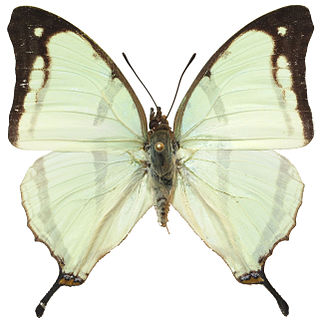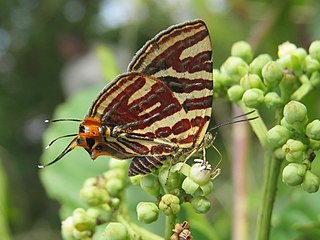
Apatura iris, the purple emperor, is a Palearctic butterfly of the family Nymphalidae.

Ampittia dioscorides, the common bush hopper or simply bush hopper, is a species of butterfly found in India, China, Indochina, Cambodia and on to Borneo, Sumatra and Java belonging to the family Hesperiidae.

Hyarotis microstictum, the brush flitter, is a butterfly belonging to the family Hesperiidae. It is found in the Indomalayan realm and in South India. H. m. coorga Evans, 1949 is the subspecies found in South India. H. m. microstictum is the subspecies found in the Indomalayan realm.

Graphium nomius, the spot swordtail, is a butterfly found in South and Southeast Asia that belongs to the swallowtail family. The species was first described by Eugenius Johann Christoph Esper in 1793. One of the grandest sights is a host of spot swordtails mud-puddling or swarming around a flowering forest tree.

Apatura ilia, the lesser purple emperor, is a species of butterfly native to most of Europe and east across the Palearctic. It is named for its similarity to the purple emperor butterfly.

The Indian fritillary is a species of butterfly of the nymphalid or brush-footed family. It is usually found from south and southeast Asia to Australia.

Ancema blanka, the silver royal, is a species of lycaenid or blue butterfly found in the Indomalayan realm. The species was first described by Lionel de Nicéville in 1894.

Hippotion celerio, the vine hawk-moth or silver-striped hawk-moth, is a moth of the family Sphingidae. It was described by Carl Linnaeus in his 1758 10th edition of Systema Naturae.

Mesapamea secalis, the common rustic, is a moth of the family Noctuidae. The species was first described by Carl Linnaeus in his 1758 10th edition of Systema Naturae. It is found in Europe, north-west Africa, Turkey and northern Iran.

Papilio forbesi is a butterfly of the family Papilionidae. It is endemic to Sumatra.

Earophila badiata, the shoulder stripe, is a moth of the family Geometridae. The species was first described by Michael Denis and Ignaz Schiffermüller in 1775. It is found from most of Europe and North Africa to the Altai Mountains in the east Palearctic.

Cyrestis lutea, the orange straight-line map-wing or little map-wing, is a butterfly of the family Nymphalidae. It is found in Indonesia.

Cyrestis achates is a butterfly of the family Nymphalidae. It is found in south-east Asia.

Chersonesia is an Indomalayan butterfly genus in the family Nymphalidae. The common name is maplet.

Papilio iswaroides is a species of swallowtail butterfly from the genus Papilio that is found in Malaysia and Sumatra. It was first described by German entomologist Hans Fruhstorfer in 1898.

Charaxes kahldeni is a butterfly in the family Nymphalidae. It is found in northern Angola, the Democratic Republic of the Congo, the Republic of the Congo, Gabon, Cameroon, the Central African Republic, Uganda and southern Sudan. Its habitat is forests.

Cigaritis lohita, the long-banded silverline, is a species of lycaenid or blue butterfly.
Zauclophora procellosa is a moth in the family Xyloryctidae. It was described by Thomas Pennington Lucas in 1901. It is found in Australia, where it has been recorded from Queensland.

Arhopala amphimuta is a species of butterfly belonging to the lycaenid family described by Cajetan Felder and Rudolf Felder in 1860. It is found in Southeast Asia - Peninsular Malaya, Sumatra, Borneo, Bangka, the Philippines, Thailand, Mergui, Burma, Langkawi, Penang and Java.

Arhopala antharita is a butterfly in the family Lycaenidae. It was described by Henley Grose-Smith in 1894. It is found in New Guinea.


















